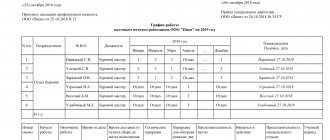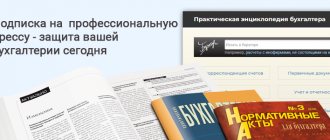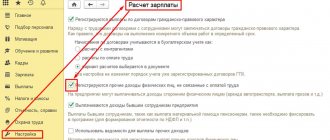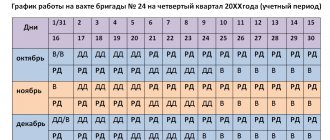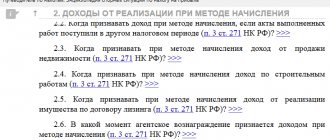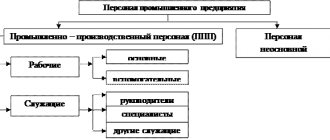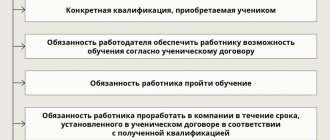Features of the rotation method
The Labor Code of the Russian Federation defines the shift method of work as a special algorithm for organizing work outside the employee’s place of residence.
The specifics are described in Chapter 47 and Article 297. It is also discussed in the Decree of the USSR State Labor Committee of December 31, 1987 No. 794/33-82, but only in that part that does not contradict the norms of labor legislation. Shift work is often used in the oil and gas industry, railway transport, and construction. An important feature of the method is that it is not a business trip. It has a time limit of 1 month. In special cases, this period is extended by management to 3 months, but the opinion of the trade union (if there is one) must be taken into account.
Work on a rotational basis according to the Labor Code of the Russian Federation is justified by a number of reasons, for example:
- lack of financial feasibility to return employees to their place of residence every day;
- remoteness of the place of work;
- the need to reduce the duration of construction procedures.
Employees in this format live:
- in settlements created by the enterprise;
- in residential premises paid for by the organization.
Legislative regulation
All the nuances of organizing a shift work method are spelled out in the Labor Code of the Russian Federation, namely in Chapter 47. The definition itself is given in Article 297 of the Labor Code.
The list of enterprises and areas of activity for which the services of shift workers are relevant is given in the “Basic provisions on the rotation method of work” under number 794/33-82.
Each organization working on a rotational basis develops Regulations based on generally accepted standards .
A sample of the Regulations on the shift method can be downloaded here.
How to introduce it at the enterprise
The Labor Code of the Russian Federation in Chapter 47 explains the algorithm for introducing exhaust at an enterprise. To do this, a number of steps are taken:
Step 1. Make a decision. This is done by the management of the organization based on:
- technical and economic calculations;
- calculating the effectiveness of the algorithm.
Step 2. Reflect the calculations in special design and technological documents. They are the basis for forming a conclusion about the advisability of using the rotation method.
Step 3. Develop an administrative document for the enterprise. It needs to reflect:
- the date of introduction of the new system in the organization;
- algorithm for settlements with employees taking into account the use of accumulated labor time;
- terms of payment, duration;
- schedule as an appendix to the document.
Step 4. Agree on the method and order with the trade union:
- by sending the project to the trade union;
- having received a motivated written review no later than 5 working days.
Step 5. Approve the agreed order. It is imperative that all employees affected by the new work schedule be familiarized with it.
Certificate from work at the place of request (sample)
Very often, an employee needs it to present it to government organizations, social security authorities, banking and credit institutions, etc. The certificate is confirmatory in nature and may contain information about the employee’s salary, his position, length of service and work experience, etc. Open and download online. At some enterprises, in order to obtain the necessary certificate from an employee, no documents are required - it is enough to contact the immediate supervisor or a representative of another structural unit with an oral request. But this is not always the case: in most, especially large companies, the employee is required to provide a written request or application for a certificate, in which he must indicate the purpose of obtaining the document and also what information needs confirmation. Dear readers! Our articles talk about typical ways to resolve legal issues, but each case is unique.
Work and rest schedule
The shift consists of a period during which work is carried out at the site, and rest time between such periods (Part 1 of Article 299 of the Labor Code of the Russian Federation).
The duration is no more than 1 month, in exceptional cases - up to 3 months (Part 2 of Article 299 of the Labor Code of the Russian Federation). But the decision to extend the period must be accompanied by the consent of the trade union.
The time for work and rest is established by the schedule (Part 1 of Article 301 of the Labor Code of the Russian Federation). The document is approved taking into account the opinion of the trade union. Employees must be familiarized with it at least 2 months in advance.
The chart reflects the dates:
- beginnings and endings;
- travel time to and from the workplace;
- time to rest.
The period of travel is excluded from the period of working time. It refers to inter-shift rest (part 2 of article 300, part 1,2 of article 301 of the Labor Code of the Russian Federation, paragraph 1,2 of clause 4.2 of the Regulations approved by the Decree of the State Committee of Labor of the USSR dated December 31, 1987 No. 794/33-82) .
Work or shift during each day is no more than 12 hours (Article 94 of the Labor Code of the Russian Federation, paragraph 3, clause 4.2 of the Resolution of the USSR State Committee for Labor of December 31, 1987 No. 794/33-82)
In some cases, overtime work is possible (according to the rules of Article 99 of the Labor Code of the Russian Federation). Overtime may accumulate in hours during a shift schedule, and these hours are not a multiple of the entire work day. Subsequently, they are summed up to a whole day of work. The employee receives them in the form of additional rest (Part 4 of Article 301 of the Labor Code of the Russian Federation).
Sample document:
REGULATIONS on shift work
GENERAL PROVISIONS
1.1. The Regulations on the shift method of work (hereinafter referred to as the “Regulations”) were developed in accordance with the Labor Code of the Russian Federation and the Resolution of the State Committee for Labor of the USSR, the Secretariat of the All-Union Central Council of Trade Unions, the Ministry of Health of the USSR dated December 31, 1987 N 794/33-82 “On approval of the Basic Provisions on the shift method of organizing work” .
1.2. The rotation method (hereinafter referred to as “shift”) is a special form of carrying out the labor process outside the place of permanent residence of workers, when their daily return to their place of permanent residence cannot be ensured.
1.3. Sending an employee on a shift is not a business trip.
1.4. Work performed on a rotational basis cannot involve workers under the age of eighteen, pregnant women and women with children under three years of age, as well as persons who have contraindications to performing work on a rotational basis in accordance with a medical certificate issued in accordance with the procedure established by federal laws and other regulatory legal acts of the Russian Federation.
1.5. Issues related to the use of the rotation method and not specified in these Regulations are resolved in accordance with current legislation.
WORK ORGANIZATION
2.1. The organization of work on a rotational basis should ensure rhythm, continuity, and complexity of work at sites (sites).
2.2. The staffing of rotational (shift) personnel is provided by employees with their consent, who are on the staff of _____ “_______________” (hereinafter referred to as the “Employer”), who do not have medical contraindications to performing work using the specified method and who live in the locations of these enterprises.
2.3. Delivery of workers on shift is carried out in an organized manner from the location of the Employer or from the collection point to the place of work and back by economically feasible modes of transport on the basis of long-term contracts concluded by the Employer with transport organizations. Transport owned by the Employer may be used to deliver employees.
The collection point is established by the Employer.
2.4. A shift is considered to be a total period, including the time of work performed at the site and the time of rest between shifts.
2.5. The duration of the shift should not exceed one month. In exceptional cases, at individual sites, the duration of the shift may be increased by the Employer to three months, taking into account the opinion of the elected body of the primary trade union organization (hereinafter referred to as the “trade union committee”) in the manner prescribed by the Labor Code of the Russian Federation and local regulations of the Employer.
2.6. When concluding (changing) an employment contract with an employee involved in work on a rotational basis, the features of the rotational method (work and rest schedule, duration of the accounting period, payment terms, provision of benefits, compensation, etc.) are reflected in the employment contract and order .
How is it paid?
Payment for work on a rotational basis (Labor Code of the Russian Federation, Chapter 47) is carried out taking into account a number of features. For example, Article 302 of the Labor Code of the Russian Federation determines the possibility of obtaining certain preferences during shift shifts. It can be:
- shift allowances;
- free housing;
- payment for travel days to and from the facility, as well as travel delays.
During the shift period, it is necessary to establish a summarized accounting of labor time (Article 300 of the Labor Code of the Russian Federation). As a rule, a time-based payment system is used: tariff rates or official salaries (Parts 2.3 of Article 129 of the Labor Code of the Russian Federation). But a piecework system can be used.
Salaries are calculated taking into account bonuses and shift allowances. Rest days paid between shifts are included in the remuneration.
IMPORTANT!
Time for rest, travel, travel delays are calculated without taking into account regional coefficients and compensation for special working conditions.
As an incentive, the manager has the right to establish incentive bonuses, which represent part of the salary (Part 1 of Article 129 of the Labor Code of the Russian Federation). The employer determines the terms of payments himself (parts 1, 2 of Article 135 of the Labor Code of the Russian Federation). The bonus is accrued to the employee's salary without taking into account payment for days that fall on rest between shifts.
Shift bonus is another compensation payment for specific working conditions. Payment is made for each actual day, as well as travel time there and back.
Sample certificate for work in the Far North
/ / December 12, 2022 0 Share A certificate for work in the Far North is a document confirming that the worker is in good physical shape and has health suitable for working in harsh climatic conditions. Our reader will learn how to issue this certificate and in what form it is drawn up from this article.
According to the order of the Ministry of Health and Social Development “On approval of lists of harmful and (or) hazardous production factors and work, during which mandatory preliminary and periodic medical examinations are carried out...” dated 04/12/2011 No. 302n, work in the regions of the Far North and areas similar in climate requires from specialists undergoing preliminary and periodic (once a year) medical examinations (clauses
4.1 and 4.4 of Appendix No. 2 to the order). Body check
Holiday rules
The Labor Code regulates vacation in the usual manner only after the days of rest between shifts have been used. The employee is guaranteed to receive 28 calendar days - the main rest. Additional days are provided for work:
- in the Far North - 24 calendar days;
- in territories equated to the Far North - 16 calendar days;
- in the south of Eastern Siberia and the Far East - 8 calendar days.
The length of service, which allows for additional rest, includes both days of shift and actual days on the road, determined by the schedule.
Certificates from the place of work: types and terms of issue
The certificate contains a description of certain events and often serves to confirm biographical or official information. A certificate from the place of work can be drawn up to confirm information about the actual place of work, position held, length of service, salary, etc. If we are talking about the main activity, then the title to the text of the certificate, for example, can be formulated - about staff turnover, about the progress of advertising campaigns, etc. Certificates are submitted to another organization or to the management of their organization.
How to register employees according to the Labor Code of the Russian Federation
To hire an employee on a rotational basis, you need to:
Step 1. Provide a medical examination at the employer’s expense.
Step 2. Conclude an employment contract, indicating in it:
- place of work with the address of the facilities where the shift is taking place;
- the fact of hiring an employee on shift;
- working hours;
- the duration of additional leave if the activity is carried out in the Far North and equivalent zones.
Step 3. Issue an order for acceptance, indicating in it that the work will be on a rotational basis, and the place where the shift workers will gather.
Step 4. When filling out a work book, indicate that your work activity is organized on a rotational basis.
Certificate of work on a rotational basis to reduce the period before marriage registration
Work certificates come in different forms and may be needed by an employee for different purposes. For example, a certificate from your place of employment may be required in the following cases:. At the same time, if an employee needs a certificate from his place of work, we will provide a sample at the end of the article, he is not obliged to inform the employer of the purposes for which it is needed. To receive a certificate, the employee must submit a written application addressed to the head of the company. The application must state in free form what the certificate should contain, the period of work in the company, the amount of salary and allowances, etc. In addition, the application must indicate other documents if they are needed as an attachment, for example, an extract from the work book, etc.
I brought a certificate stating that I was on housing and communal services shift.” the employer must issue a certificate of work at this enterprise, as well as 2 personal income taxes.
Hiring algorithm for performing work on a rotational basis
The shift method of work is a specific form of labor organization, due to the inability to ensure the daily return of workers to their place of permanent residence.
This method of work is in demand in the labor market and is widespread in construction, forestry, mining and other industries.
The labor regime for a rotational work method, as a rule, involves maintaining summarized records of working time. In addition, the organization must develop and put into effect a regulation on the performance of work on a rotational basis or another provision that spells out compensation for the performance of work on a rotational basis, a list of professions and positions of workers for whom compensation is established for the performance of work on a rotational basis must be drawn up and approved, as well as a schedule of work on shifts and, if necessary, a schedule for the delivery of workers to rotation camps <*>.
Let's give an approximate algorithm for hiring a shift worker.
Step 1. We send the applicant for a preliminary medical examination
Step 2. We receive from the applicant the documents necessary for employment
Step 3. We familiarize the employee with local legal acts
Step 4. Conclude an employment contract in writing
Step 5. We issue an administrative document on hiring
Step 6. We draw up (fill out) a work book
Step 7. Form the employee’s personal file (if necessary)
Step 8. Fill out personal employee cards (if necessary)
Step 9. Permission to work
Step 10. Notify the relevant government authorities
We send the applicant for a preliminary medical examination
Persons sent to work on a rotational basis undergo preliminary medical examinations at health care organizations no later than 10 days before their departure to the place of work <*>.
To undergo a preliminary medical examination, the employer issues to persons applying for work a direction indicating production, profession, harmful and (or) dangerous factors in the working environment, indicators of the severity and intensity of the labor process in accordance with Column 2 of Appendices 1 - 3 to Instruction No. 47 <*>.
Upon completion of the preliminary medical examination, the person who has passed the medical examination is issued a medical certificate of health <*>.
If, according to this medical certificate, a person applying for work has contraindications for work, then the employer must refuse to hire him <*>.
We receive from the applicant the documents necessary for employment
The list of documents that the employer must require and the future employee must present is contained in Part 1 of Art. 26 TK. Without these documents, employment is not allowed. It is prohibited to require other documents not provided for by law <*>.
At the same time, if an applicant is applying for a job for the first time, he will not be able to present a state social insurance certificate and a work book when applying for a job. After employment, these documents will need to be issued to the employee <*>.
A state social insurance certificate that is lost or otherwise unusable is subject to restoration upon a written application from the employee <*>.
If the work book is lost by the applicant or damaged, then no later than 15 days after hiring, the employer issues a duplicate of it. The employee must write a corresponding application for the issuance of a duplicate work book <*>.
We familiarize the employee with local legal acts
When hiring, the employer is obliged to familiarize the employee, against signature, with the current LPA <*>.
As a rule, each LPA is accompanied by a familiarization sheet, which includes fields for the employee’s personal signature, the date of familiarization and the transcript of the signature (full name).
The employer's LPA includes PVTR, job (work) instructions, collective agreement, regulations on work on a rotational basis, regulations on wages, regulations on bonuses, regulations on the department (service) of the organization, regulations on trade secrets, regulations and instructions on labor protection and etc.
It should be explained to the employee that the LPA must be read carefully, since failure to comply with many of them in the future may subject him to disciplinary action.
We conclude an employment contract in writing
With an employee hired, an employment agreement (including a contract) is concluded in writing, drawn up in two copies and signed by the parties. One copy is given to the employee, the other is kept by the employer <*>.
The contents and conditions of the employment contract are listed in Art. 19 TK. The condition that the employee will perform work on a rotational basis may be stated in the employment contract.
An example of wording in an employment contract: “The work is performed on a rotation basis according to the work schedule.”
In addition, the employment contract must include a clause regarding compensation for work performed on a rotational basis <*>:
1st method: the employment contract specifies a fixed amount of compensation or a percentage of the tariff part of the salary (for example, the official salary) for performing work on a rotational basis.
Example of wording in an employment contract: “The employee is compensated for performing work on a rotational basis in the amount of 9 (nine) rubles for each day of work performed at the site”;
2nd method: the employment contract contains a reference to the employer’s LPA, which establishes the amount and procedure for payment of this type of compensation. For example, to the regulations on wages or regulations on the performance of work on a rotation basis.
An example of wording in an employment contract: “The employee is compensated for performing work on a rotational basis in accordance with the Regulations on the remuneration of employees of the organization.”
We issue an administrative document on employment
After concluding an employment contract in the prescribed manner, employment is formalized by order (instruction) of the employer (hereinafter referred to as the order). The order is announced to the employee against signature <*>.
The employment order, in our opinion, may contain the following information:
— date of hiring;
- FULL NAME. the person being hired;
— name of the position (specialty, profession);
— name of the structural unit;
— conditions of employment and nature of the work;
— wage system;
— the period of preliminary testing, if it is established when concluding an employment contract.
Note: The recommended form of employment order is contained in the USORD.
We draw up (fill out) a work book
Work books are filled out by the employer for all employees working for more than five days, including those entering work for the first time, if the work for this employer is the main one for the employee <*>.
Work books are filled out according to the rules established by the Instructions on Work Books. The work book does not indicate that the work is performed on a rotational basis.
For the issuance of a work book to a person applying for work for the first time, as well as to replace a lost or damaged one, see step 2
We create the employee’s personal file (if necessary)
The employee’s personal file is formed after the conclusion of an employment agreement (contract) and the issuance of an order for employment <*>.
Personal affairs must be maintained <*>:
- on managers;
— specialists;
— scientific workers;
- civil servants;
— other employees in cases determined by the legislation of the Republic of Belarus.
We also believe that it is necessary to create a personal file (for example, for workers, employees), if this is established by the employer’s LPA.
The composition of personal file documents is determined by clause 6 of the Instructions on the procedure for maintaining personal files.
The generated personal file is registered in the personal affairs journal (book) <*>.
We fill out personal cards of employees (if necessary)
It is mandatory to maintain personal military registration cards in accordance with Form 2 to Appendix 2 of the Instructions on the procedure for maintaining military registration <*>.
For information, conscripts and those liable for military service are subject to military registration. Conscripts include male citizens assigned to a conscription station, and those liable for military service include citizens in the reserves of the Armed Forces or other military formations of the Republic of Belarus <*>.
The personal card of a conscript is filled out on the basis of a passport and a conscript's identification card, and for a person liable for military service - on the basis of a passport and a military ID <*>.
As for personal employee cards, it is currently not necessary to fill them out. If it is necessary to use them, the employer can independently develop the form and procedure for maintaining such a card. In this case, you can focus on the no longer valid T-2 form.
We provide permission to work
When hiring, the employer is required to conduct an introductory briefing on labor protection <*>.
In addition, the hired employee may also undergo initial training on labor protection. The need for initial instruction on labor protection is determined by the nature of the work to which the employee is involved. Part 1, clause 55 of Instruction No. 175 sets out the list of works for which such instructions are not carried out before performing them. At the same time, the list of professions and positions of workers exempt from initial training at the workplace is compiled by the labor protection service with the participation of the trade union and approved by the head of the organization <*>.
Also, persons hired for permanent or temporary work are given introductory fire safety training. Labor safety briefing can be carried out together with fire safety briefing if the labor safety briefing program fully addresses the issues of fire safety briefing <*>.
The conduct of briefings is recorded in the appropriate journals using forms in accordance with Appendices 4, 8 to Instruction No. 175 and in accordance with Appendix 3 to Instruction No. 36 <*>.
For reference, the initial briefing can be recorded in a personal occupational safety card in the form in accordance with Appendix 3 to Instruction No. 175 instead of the journal <*>.
In addition, it should be determined whether the employee needs to undergo an internship in labor protection. The organization must have a list of worker professions approved by the manager, as well as a list of positions for specialists who must undergo internships. The first list establishes its duration (at least two working days) depending on the qualifications of the workers and the types of work they perform <*>.
The internship is formalized by an appropriate order <*>.
An example of the wording of an order to organize an internship: “I ORDER: 1. Conduct an internship for Andrey Vasilyevich PETROVSKY, 3rd category boiler room operator, for two working days from May 28 to 29, 2022.2. Appoint site foreman Evgeniy Valerievich ANDRUKHOV as the supervisor of the internship.3. Entrust control over the execution of the order to labor safety engineer Tatyana Andreevna RYSINA.”
The admission of workers to independent work is carried out by the head of the organization (structural unit) and is formalized by an order (instruction) or an entry in the labor safety briefing log in the form in accordance with Appendix 4 to Instruction No. 175 <*>.
An example of the wording of an order for admission to independent work: “ADMIT: PETROVSKY Andrey Vasilievich, boiler room operator of the 3rd category, to independent work from 05/30/2019 in connection with an internship from May 28 to 29, 2022, as well as a knowledge test on labor protection issues 05/30/2019″.
We notify the relevant government authorities
The employer is obliged to inform the Federal Social Security Service about the hiring of each new employee: on the basis of the employment order, form PU-2 is submitted to the Federal Social Security Service (form type - original). The notification period is once a quarter no later than the 10th day of the month following the reporting quarter <*>.
An exception is for persons who exercise, in the same quarter in which they were hired, their right to receive a pension (recalculation of the assigned pension, transfer from one type of pension to another). The rules for submitting form PU-2 (type of form - original) are enshrined in part 2, clause 15 of the PU Rules.
Features of the notification for individual categories of workers are set out in the table.
Table
| Category of workers | Authority to be notified | notice period | Consequences of failure to notify | NPA |
| Citizens who are or are required to be registered with the military | Military registration and enlistment office (separate unit) | 1 month | Administrative liability under Part 2 of Art. 25.8 Code of Administrative Offenses | Paragraph 2 hours 1 tbsp. 9 of the Law on Military Duty |
| Citizens who are or are required to be registered with the military in the reserve of state security agencies | Regional KGB Directorate | |||
| Pensioners | Body providing pensions (FSZN) | 5 days | Overpaid pension amounts are recovered from the employer | Part 1 art. 93 of the Pension Law |
Structure of an employment contract on a shift basis
The general structure of employment contracts for shift workers does not differ from the usual one. In practice, it includes the following information:
- subject of the contract;
- the procedure for the entry into force of the agreement;
- rights and obligations of the employee and employer;
- work and rest schedule;
- terms of remuneration, provision of guarantees and compensation;
- social insurance of employees;
- responsibility of the employee and employer;
- conditions for changing and terminating the contract;
- settlement of disputes;
- final provisions
- other terms of the contract;
- details and signatures.
